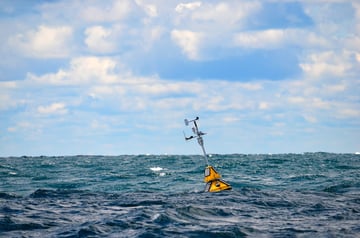A classic pattern unfolds over the North Sea this week; with low pressure over the northern Atlantic and the Norwegian Sea on one hand, and high pressure over eastern Europe and western Russia on the other. In between, the North Sea generally faces a south(west)erly orientated airflow, veering to (north)west during the second half of the week as an area of high pressure approaches the UK.
In general the weather pattern over the North Sea allows for rather calm conditions to prevail over the southern North Sea this week as the influence of high pressure is more pronounced over there. Winds will be moderate to fresh, 3 to 5 Bft, with Hs near or below 1.5m. Further north though, the impact of Atlantic lows can be felt more clearly, with on Tuesday southerlies peaking at near gale force, 7 Bft. Associated Hs will reach 3.5-4.0m in the course of the day. During the evening wind and waves will gradually abate.
 (Fig1. Near gale force winds over the N North Sea well into Tuesday. Hs regionally reaches 3.5-4.0m. Things will calm down in the course of the evening.)
(Fig1. Near gale force winds over the N North Sea well into Tuesday. Hs regionally reaches 3.5-4.0m. Things will calm down in the course of the evening.)
On Thursday a (weak) frontal trough crosses the North Sea with most activity in the northeastern quadrant. In its wake moderate to fresh westerlies spread out over the area while a ridge of high pressure gains influence from the southwest. Hs should remain between 0.5-1.5m for most locations, with lowest waves to the south.
However, for the northern North Sea the durability of this calmness becomes questionable later on Thursday and on Friday. Models currently disagree on the position, depth and track of an area of low pressure moving into the Norwegian Sea by then. The wind field on its southern flank might enter the northern North Sea, possibly resulting in a fresh to strong (north)westerly breeze, 5 or 6 Bft, and Hs up to 2.0-2.5m in the far north.
During the weekend high pressure becomes predominant as a ridge, associated with the Azores high, spawns a separate high over the North Sea. Obviously, calm conditions will prevail by then.


.png?width=360&name=swc-maritiem_0311%20(1).png)
